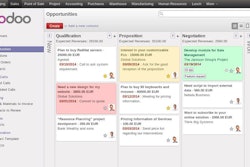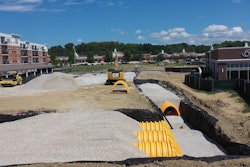
As digital construction workflows between owners, designers, general contractors and subcontractors replace paper-based processes, one party will typically specify a software platform as the system of record for project communications.
This can create challenges both during and after the project.
This system may increasingly be specified by the project owner, but general contractors sometimes extend their system of record, like Procore, to the project team as well. Autodesk on March 31 announced new functionality for its Autodesk Construction Cloud that streamlines and provides enhanced control for sharing Sheets and files between companies and individuals collaborating on a construction project.
The Bridge Collaboration Solution is now a native feature of Construction Cloud, included with all subscriptions and interwoven throughout the application.
Prior to the addition of Bridge, data within a Construction Cloud project could be shared with other collaborators, but this net new functionality provides more granular control over what is shared with who.
Bridge enables parties to a project to share files and Sheets, either generically across project collaborators or with specific groups or individuals. Sheets are two-dimensional drawings in Autodesk Build that can be enriched with hyperlinked callouts and markup capabilities. Documents, most commonly PDF files, can be uploaded to Autodesk Build and converted to Sheets.
Bridge features include:
- Share files, folders or sheets across different projects or accounts
- Set up automations for sheet sharing for enhanced revision control
- Import sheets from other projects where you have project administrative privileges
- Create bridged projects for direct project linking to simplify share workflows
- View and manage a summary list as an audit trail of outgoing shares
Prior to Bridge, to share material with select audiences, Autodesk Construction Cloud users would route documents back and forth by email and other means, leading to discontinuous workflows.
“There are some instances where you want to give access to everyone on the project, so everyone is adding information from the same set of documents,” Autodesk Technical Solutions Executive Neetha Puthran said in briefing call with ForConstructionPros. “If you have a project and you own the project, you can enable everyone to create issues on the project. In other cases, it is desirable to have numerous tiers of permission levels, and Bridge enables users to mix and match permissions based on role, company name and email addresses.”
Post-Project Access
In Autodesk and in other products like Procore, once a project is closed out, collaborators who are not the license holder and are simply given access to the application by a general or lack the proper permissions will no longer be able to access data in the project. This might be desirable, as in cases when a contractor is not performing and is removed from the project. But in other cases, subcontractors in particular want to retain access to project data after the fact for analysis, particularly to support future estimating by looking at actual costs in past, similar, projects.
“Subcontractors can use Bridge to support future estimating,” Autodesk Product Manager Jadie Fanganello said in a briefing with ForConstructionPros. “Before this, if they were removed from a project, they had no historical record. But at the end of the project, they own all of that information and can manage it within their own account.”
This would, Fanganello clarified, still require the contractor to have a paid subscription to Construction Cloud.
But Puthran made clear there are other means for a subcontractor with whom sheets and files are shared to retain access to these materials.
“There are a couple different ways to do it—if the outcome they want is a closeout package, they can extract that to a Zip file and synch it to another project management system.”
Procore and Autodesk both have partnerships with data analytics vendor ProNovos that captures and extends value of a subcontractor’s data after project closeout. With Bridge, subcontractors could have an easier time retaining material shared with them in Autodesk for analysis after project closeout.
Importance of Unified Architecture in Construction Software
The construction software space is maturing to the point where we are starting to see consolidation happen through mergers and acquisitions. In many cases, a larger company will acquire multiple applications and set about marketing them as a product line. But extending research and development efforts across that set of applications is difficult because they are all built on different infrastructures. Even if the vendor places them all behind a common interface, the different products are still using different technologies in the middle tier and different databases as well as different data structures. Even uniting different applications with application programming interfaces (APIs) delivers limited value as the integration can be brittle, breaking when one or the other applications change, and rigid because the way data and processes hand off from one application to another is limited hard to change or reconfigure.
Autodesk was able to deliver Bridge across all of Construction Cloud because they had done the work on their acquired products to move them to a common architecture.
“What we did on the back end of things was restructure how these things work,” Puthran said. “Everything fits on a common data environment and can consume different types of data that is understood by the platform.”
Autodesk for instance acquired PlanGrid in 2018, a construction productivity solution that united the front office with the field, and building information management (BIM) content management system Assemble Systems.
“For Autodesk Build, we redid PlanGrid and BIM 360, which became Autodesk Build,” Puthran said. “Autodesk was acquiring all these different products, and one of them, PlanGrid, which Autodesk did not need to re-invent. It was pre-built (with an appropriate architecture), which was part of its appeal.”
Other products, including Assemble Systems and estimating software package ProEst, acquired in December of 2021, remain outside the core Autodesk Build application.
“For ProEst, we have integrations, but it has not been rebuilt as part of the platform,” Puthran said. “For Assemble Systems, we did already have open APIs.”
As the application currently stands after this unification process, Autodesk Construction Cloud is the overall platform, underpinned by Autodesk Docs, a common data environment. Beneath Autodesk Docs is Autodesk’s development platform, Forge, which they used to create Autodesk Docs. Forge also serves as a development sandbox where independent software vendors (ISVs) and system integrators that are part of the Autodesk ecosystem can develop complementary applications.
The progression towards this unified, agile platform did not happen all at once.
“We started in construction way back in 2006—when we bought the first cloud-based project management system called Constructware,” Autodesk Senior Director and Head of Construction Strategy Sid Haksar said. “This was before cloud was really catching on, so we were early to the game. Then, we got hammered with the financial crisis and made a deliberate decision to prioritize with architects and engineering where we had made a big bet when we acquired Revit in 2003. And then in 2007 we acquired Navisworks, which has been a hero product for us. In 2011 we bought Horizontal Systems, which is model collaboration and is now re-named Glue. Finally, in 2012 we bought a company called Vela Systems, which became BIM 360 Field.”
Under CEO Carl Bass, Autodesk focused more on manufacturing than construction, but Haksar said this tune changed when Andrew Anagnost took on the top spot in 2017.
“One of the things I am really excited about with Construction Cloud is how it is intimately tying our design tools in with the construction process,” Anagnost said in a 2019 Autodesk video. “So it is moving from design to preconstruction all the way to execution and everything in between and it is bringing it all together in the cloud. That is going to solve some enormous workflow and productivity problems as more and more people use Construction Cloud. We’re going to deliver predictive analytics on top of that that help people make better decisions before they start the project.”
Now, Haksar said the company is focusing on building out a constituency for this fully absorbed, rationalized and re-imagined solution and the development platform it rests on.
“When we made the acquisitions—like with PlanGrid, we spent $875 million acquiring the company,” Haksar said. “We knew there was some level of overlap with BIM 360. So, we spent the last two years turning these two into one unified construction platform, moving away from point solutions we have acquired.”
With Construction Cloud, Autodesk is targeting general contractors, and even owners, and has secured a customer base of thousands of generals and hundreds of thousands of subcontractors.
“We are also going more into owners, and we have been servicing owners on the design side of the house—they are already customers,” Haskar said. “Serial builders want more of a say in how their projects progress, and they have been a receptive audience for Construction Cloud.”
BOTTOM LINE: Other construction technology companies, both large and small, have since followed Autodesk, engaging in their own acquisitions. Companies like Command Alkon, which grew extensively by acquisition, and Autodesk, are examples of companies that have come through the process of melting down their acquired products, recasting them as cloud native, multi-tenant software-as-a-service (SaaS) solutions. Many products being acquired and rolled up into portfolios right now are mature and boast robust functionally, but are architected for on-premise deployment and currently hosted in a cloud environment. Contractors evaluating or considering software applications that have recently been part of acquisition sprees will want to ask themselves and their vendor where these products are headed, what investments are being made in them and what their roadmap for interoperability and evolution into the future consists of. These software products may also benefit from being re-imagined either as multi-tenant applications or single tenancies built for better performance and easier deployment in the cloud. Autodesk’s experience with acquisitions and a gradual evolution towards a unified platform is an excellent example of how this should work. And that is why it was able to deliver something like the new Bridge functionality and extend it across what had been separate, acquired products.

















